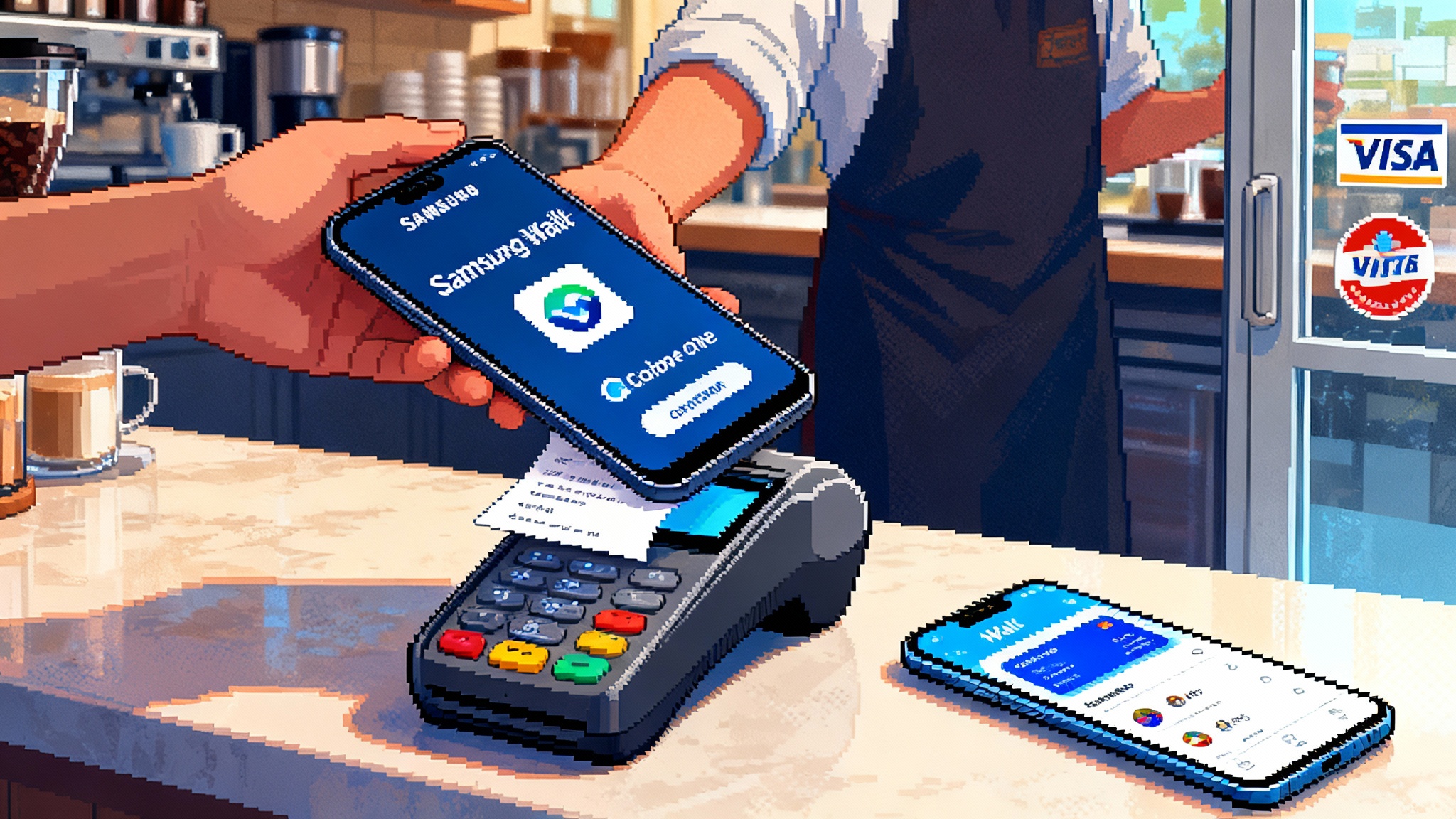Samsung makes Galaxy Wallet crypto-native with Coinbase
On October 3, 2025, Samsung gave U.S. Galaxy owners special access to Coinbase One inside Samsung Wallet, turning the default phone wallet into a crypto on-ramp and previewing how OEM-native wallets could reshape stablecoin spend and DeFi access.

Breaking: Galaxy Wallet just became a crypto on-ramp
On October 3, 2025, Samsung expanded its partnership with Coinbase and gave U.S. Galaxy users special access to Coinbase One inside Samsung Wallet. The rollout includes an in-app path to buy crypto with Samsung Pay, a three month Coinbase One trial, and a $25 credit after a first trade. Samsung framed it as the next step after a July pilot that let users fund Coinbase from Samsung Pay. Read the details in Samsung's October 3 announcement.
In plain terms, a default phone wallet just learned a crypto trick. You open the wallet you already use for tap to pay, IDs, and transit, then add crypto without hunting through app stores or onboarding funnels. The wallet becomes an on-ramp. The on-ramp lives where your payments habit already is.
This is a bigger deal than a perk subscription. It marks the moment when hardware makers use their native wallets as distribution engines for web3. If you are a builder, a merchant, or a consumer who has never touched a seed phrase, this matters because it changes where the journey begins.
Why OEM-native wallets are the new distribution edge
Phone makers have the four ingredients that crypto apps spend heavily to acquire.
- Default placement and trust
- The wallet is preinstalled, pinned to the taskbar, and invited into day one setup. That is free shelf space and free mind share.
- People already use it for everyday payments and tickets, so the hurdle to try one more feature is low. Trust transfers from card tap to crypto buy.
- Lower customer acquisition cost
- Exchanges and wallets spend to lure users through ads and referral bonuses. An icon in a default wallet replaces a chunk of that spend.
- OEM partners can push software updates, in-device banners, and setup wizards. That is a marketing channel with zero ad auction.
- Seedless and passkey sign-in
- Modern phones support passkeys secured by the device’s hardware enclave. The login feels like unlocking your phone. No passwords to forget.
- When passkeys are combined with exchange accounts, the entry friction drops. The user does not juggle a seed phrase just to try a ten dollar stablecoin buy.
- A path to gas-abstracted payments
- Many consumer wallets now hide network fees by paying them on behalf of the user and charging a single line item at checkout. Phones can make that model feel native, similar to how a rideshare app charges one total instead of listing road tolls.
Put together, these advantages turn a wallet from a passive card holder into an active funnel. With Samsung’s move, crypto is no longer a separate app category. It is a tab inside a wallet millions already open at checkout. For broader context on distribution, see our look at the rails that could reshape crypto.
The July preview and the October upgrade
Samsung did not jump straight to this. In late July, Samsung Pay started rolling out as a funding method inside the Coinbase app for users in the United States and Canada. That was the plumbing. The October integration brings the experience back into Samsung Wallet with a clear incentive, the Coinbase One trial and credit. The result is a loop. You can start in Samsung Wallet, buy in Coinbase, and continue managing money in the same place you keep cards and passes.
Why that loop matters
- It reduces the time from intent to first purchase. You are already in a payment context, so you buy instead of bookmarking.
- It anchors crypto next to the cards and passes you rely on daily. That placement signals legitimacy to mainstream users who have avoided app store hunts and unknown brands.
The stablecoin flywheel starts at checkout
The first mainstream use case in this new funnel is likely not speculative tokens. It is stablecoin spend. Here is why.
- People understand the idea of a digital dollar they can send quickly. They do not need a thesis about governance tokens to see the benefit of instant settlement and low fees for peer to peer transfers. For deeper context on issuer controls and safety, see the control layer stablecoins need.
- Card networks are building bridges that make stablecoins work behind the scenes. On July 31, 2025, Visa announced it would expand stablecoin settlement to more coins and more blockchains, including support for PayPal USD and Global Dollar, plus the addition of Stellar and Avalanche. It also added support for Circle’s euro stablecoin. See the specifics in Visa's July 31 expansion.
What that actually means for a shopper
- You tap your phone and the merchant still sees a card sale. The card issuer and acquirer may settle part of the funds in stablecoins on-chain, which can be faster and cheaper. To you, it feels like your usual checkout.
- As settlement rails mature, wallets can offer perks for on-chain settlement. For example, they could waive a fee or deliver instant refunds because the money moves 24 by 7. Those are real consumer reasons to choose the default wallet that gets the best rates.
Practical example
- A small online seller uses a payment provider that supports stablecoin settlement. When you pay with your Galaxy wallet, the provider sweeps funds in near real time to the seller’s account. The seller gets liquidity faster, the provider reduces treasury friction, and you see a normal receipt. No new behavior required.
DeFi access without the maze
After stablecoins, the next milestone is DeFi access that does not look like DeFi. In the old flow, a curious user had to download a wallet, guard a seed, buy crypto on an exchange, bridge to the right chain, then approve a half dozen transactions just to test a lending pool. Most people will not do that.
The new model simplifies the sequence.
- On-ramp inside the default wallet lowers the barrier to a first deposit.
- Passkey authentication removes the password reset spiral.
- Gas abstraction and bundled approvals compress multi step tasks into confirm screens that read like bank app flows.
This is where Coinbase One inside Samsung Wallet is strategically interesting. A subscription with zero trading fees on select assets and boosted staking rewards is not only a price incentive. It is a packaging strategy. It says, we will turn a set of opaque actions into a membership with clear benefits, then place that membership where you already manage money. When paired with phone level security like biometrics and a secure element, the mental model starts to look like mobile banking, not hobbyist software.
For builders, the message is clear. If you want the next million normie users, meet them in the wallet they already trust and remove one decision for every tap you ask them to make.
What to watch next
KYC flows that feel like sign in, not sign up
- Expect pre-filled identity checks that use what the phone already knows about you, with explicit consent gates. The goal is to reduce the fifteen minute form into a two minute confirm.
- Action: builders should invest in progressive know your customer, where a small purchase unlocks within light verification, and deeper limits unlock after risk checks. Present the path up front so users know what to expect.
Recovery risk, explained without jargon
- Custodial accounts, like a standard exchange login, are recoverable with email and identity checks, which non technical users appreciate but which introduce platform risk. If the platform locks the account, users wait.
- Self custody can be made seedless through passkeys, secure enclaves, and multi party recovery. That shifts risk from a single custodian to a set of devices and guardians, but it requires good product education.
- Action: wallets should offer a simple comparison screen at first run that shows who holds the keys, how recovery works, and what happens if a phone is lost. No marketing fluff, just a table and a recommended choice for beginners.
Merchant rails beyond pilots
- The Visa expansion and similar efforts will matter only when acquirers and processors expose the benefits in merchant dashboards. Faster settlement, lower dispute costs, and weekend liquidity are the selling points.
- Action: payment providers should test stablecoin settlement with a narrow segment where the benefit is obvious, for example weekend sales for nightlife venues or marketplace payouts. Publish the before and after metrics, including days sales outstanding. Banks are also moving toward compliant digital dollars, as covered in banks race to mint dollars.
Whether Apple and Google follow
- Apple Wallet and Google Wallet already sit at the top of the mobile payment funnel. If they add in wallet on-ramps or privileged partner tiles for regulated crypto services, the distribution curve steepens overnight.
- Constraints differ. Platform rules, regional licensing, and policy risk will govern timelines. The signal to watch is not a press release about a pilot. It is when a mainstream user can tap a wallet tile, pass a lightweight identity check, and buy a stablecoin without leaving the wallet.
The builder and merchant playbook
For app developers and exchanges
- Design for the home court advantage of the device. Use passkeys by default, avoid passwords, and tie critical approvals to biometric prompts that users already trust.
- Offer gas abstraction, not as a hidden fee, but as a clear line item. Describe what it covers in normal language and let users choose speed options that map to familiar delivery metaphors like economy, standard, express.
- Invest in enterprise grade support. When crypto lives inside a default wallet, support expectations match banking, not hobby apps. Fast account recovery and human escalation will matter more than an extra token listing.
For merchants and payment providers
- Pilot stablecoin settlement where it helps cash flow. Pick a use case with measurable pain, like weekend liquidity gaps or cross border payouts. Run a small randomized test and publish the cash conversion cycle improvement.
- Train support staff on the difference between consumer experience and back end settlement. Shoppers should not need to hear about blockchains at checkout. They should see faster refunds and fewer declines.
For security and risk teams
- Align wallet protections with the value at risk. If the wallet now holds a path to assets, require step up authentication for large orders and new devices. Tie high risk actions to hardware attestation.
- Build clear incident playbooks. If a phone is lost, show the steps to revoke device access from a second device or a web portal. If a user suspects fraud, prioritize account freezes that can be undone quickly after verification.
The consumer view: try it without changing your routine
If you are crypto curious, this is an easy time to test without changing habits.
- Open Samsung Wallet, look for the Coinbase tile or promotion, and start with a small amount you can afford to learn with.
- Use passkeys and biometric prompts whenever offered, then enable step up checks for larger purchases.
- Treat the Coinbase One trial as a sandbox window to evaluate whether you like the experience. Track the real costs, not just headline fees, including spreads and network charges that may be bundled or waived.
You can do all of this inside the same wallet you use at grocery checkout. That familiarity is the point.
What this signals about the next era of wallets
Today’s news hints at a larger pattern. The phone wallet is becoming the universal entry point for money, identity, and access. Cards, transit passes, hotel keys, and now a crypto on-ramp live in one container. Once a feature reaches that container, it graduates from niche to normal.
There will be tradeoffs to navigate, particularly around custody, recovery, and data sharing. There will be policy questions about where know your customer stops and device identity begins. But the direction is clear. The companies that control the first screen at checkout will shape how new payment rails reach the mass market.
Samsung and Coinbase just showed one path. A July funding integration set the pipes. An October Wallet experience put crypto where daily payments live. Visa and peers are turning on stablecoin settlement in the background. Builders now have a map. Merchants have a reason to experiment. Consumers have a low friction way to explore without leaving familiar ground.
The conclusion: the default wallet is the new browser homepage
For twenty years, the browser homepage decided what most people saw on the internet first. Today, the default wallet is on track to decide how most people see new forms of money. Put a polished on-ramp inside it, add passkey sign in, hide the gas math, and suddenly web3 looks like a normal payments feature. The winners will be the teams that design for this default, not against it, and the platforms that make the boring parts fast, safe, and invisible.








